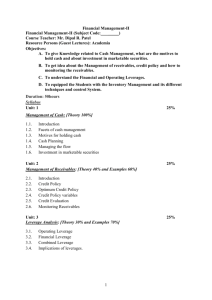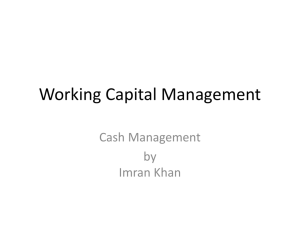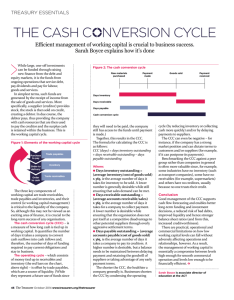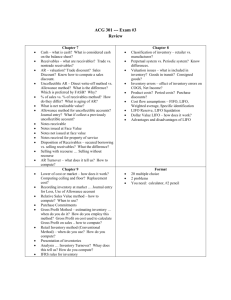Campus Location: Georgetown, Dover, Wilmington Effective Date
advertisement
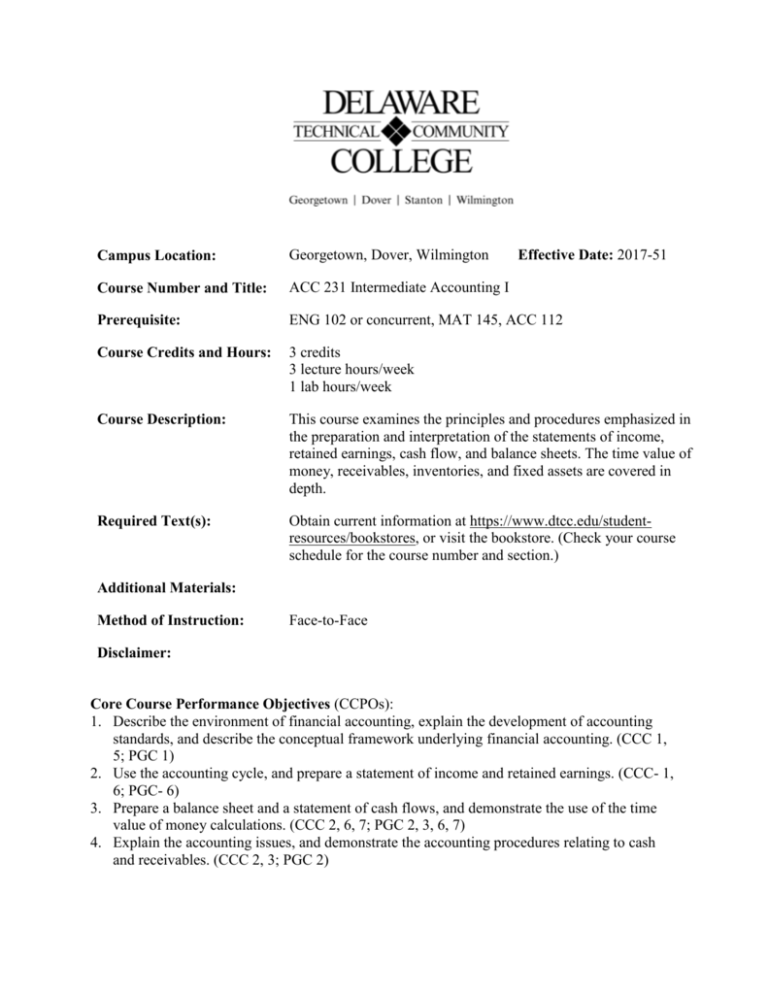
Campus Location: Georgetown, Dover, Wilmington Effective Date: 2017-51 Course Number and Title: ACC 231 Intermediate Accounting I Prerequisite: ENG 102 or concurrent, MAT 145, ACC 112 Course Credits and Hours: 3 credits 3 lecture hours/week 1 lab hours/week Course Description: This course examines the principles and procedures emphasized in the preparation and interpretation of the statements of income, retained earnings, cash flow, and balance sheets. The time value of money, receivables, inventories, and fixed assets are covered in depth. Required Text(s): Obtain current information at https://www.dtcc.edu/studentresources/bookstores, or visit the bookstore. (Check your course schedule for the course number and section.) Additional Materials: Method of Instruction: Face-to-Face Disclaimer: Core Course Performance Objectives (CCPOs): 1. Describe the environment of financial accounting, explain the development of accounting standards, and describe the conceptual framework underlying financial accounting. (CCC 1, 5; PGC 1) 2. Use the accounting cycle, and prepare a statement of income and retained earnings. (CCC- 1, 6; PGC- 6) 3. Prepare a balance sheet and a statement of cash flows, and demonstrate the use of the time value of money calculations. (CCC 2, 6, 7; PGC 2, 3, 6, 7) 4. Explain the accounting issues, and demonstrate the accounting procedures relating to cash and receivables. (CCC 2, 3; PGC 2) 5. Explain the accounting issues, and demonstrate the accounting procedures relating to inventories. (CCC 2, 3; PGC 2) 6. Explain the accounting issues, and demonstrate the accounting procedures relating to the acquisition and disposition of plant, property, and equipment. (CCC 2, 3; PGC 4) See Core Curriculum Competencies and Program Graduate Competencies at the end of the syllabus. CCPOs are linked to every competency they develop. Measurable Performance Objectives (MPOs): Upon completion of this course, the student will: 1. Describe the environment of financial accounting, explain the development of accounting standards, and describe the conceptual framework underlying financial accounting. 1.1 1.2 1.3 1.4 1.5 1.6 1.7 1.8 1.9 1.10 1.11 1.12 1.13 1.14 1.15 1.16 1.17 1.18 Identify the major financial statements and other means of financial reporting. Explain how accounting assists in the efficient use of scarce resources. Identify some of the challenges facing accounting. Identify the objectives of financial reporting. Explain the need for accounting standards. Identify the major policy-setting bodies and their role in the standards-setting process. Explain the meaning of generally accepted accounting principles. Describe the impact of user groups on the standard-setting process. Explain issues related to ethics and financial accounting. Describe the conceptual framework underlying financial accounting. Describe the usefulness of a conceptual framework. Describe the Financial Accounting Standards Board’s (FASB) efforts to construct a conceptual framework. Explain the objectives of financial reporting. Identify the qualitative characteristics of accounting information. Define the basic elements of financial statements. Describe the basic assumptions of accounting. Explain the application of the basic principles of accounting. Describe the impact that constraints have on reporting accounting information. 2. Use the accounting cycle, and prepare a statement of income and retained earnings. 2.1 2.2 2.3 2.4 2.5 2.6 2.7 2.8 2.9 2.10 2.11 Explain basic accounting terminology. Explain double-entry rules. Identify steps in the accounting cycle. Record transactions in journals, post to ledger accounts, and prepare a trial balance. Explain the reasons for preparing adjusting entries. Prepare closing entries. Explain how inventory accounts are adjusted at year-end. Prepare a 10-column work sheet. Identify the uses and limitations of an income statement. Prepare a single-step income statement. Prepare a multiple-step income statement. 2.12 2.13 2.14 2.15 2.16 Explain how irregular items are reported. Explain intraperiod tax allocation. Explain where earnings-per-share information is reported. Prepare a statement of retained earnings. Explain how other comprehensive income is reported. 3. Prepare a balance sheet and a statement of cash flows, and demonstrate the use of the time value of money calculations. 3.1 3.2 3.3 3.4 3.5 3.6 3.7 3.8 3.9 3.10 3.11 3.12 3.13 3.14 3.15 3.16 3.17 3.18 Identify the uses and limitations of a balance sheet. Identify the major classifications of the balance sheet. Prepare a classified balance sheet using the report and account formats. Identify balance sheet information requiring supplemental disclosure. Identify major disclosure techniques for the balance sheet. Indicate the purpose of the statement of cash flows. Identify the content of the statement of cash flows. Prepare a statement of cash flows. Discuss the usefulness of the statement of cash flows. Identify accounting topics where time value of money is relevant. Distinguish between simple and compound interest. Learn how to use appropriate compound interest tables. Identify variables fundamental to solving interest problems. Solve future and present value of one problems. Solve future value of ordinary and annuity due problems. Solve present value of ordinary and annuity due problems. Solve present value problems related to deferred annuities and bonds. Apply the expected cash flow approach to present value measurement. 4. Explain the accounting issues, and demonstrate the accounting procedures relating to cash and receivables. 4.1 4.2 4.3 4.4 4.5 4.6 4.7 4.8 4.9 Identify items considered cash. Indicate how cash and related items are reported. Define receivables, and identify the different types of receivables. Explain accounting issues related to recognition of accounts receivable. Explain accounting issues related to valuation of accounts receivable. Explain accounting issues related to recognition of notes receivable. Explain accounting issues related to valuation of notes receivable. Explain accounting issues related to disposition of accounts and notes receivable. Explain how receivables are reported and analyzed. 5. Explain the accounting issues, and demonstrate the accounting procedures relating to inventories. 5.1 Identify major classifications of inventory. 5.2 Distinguish between perpetual and periodic inventory systems. 5.3 Identify the effects of inventory errors on financial statements. 5.4 5.5 5.6 5.7 5.8 5.9 5.10 5.11 5.12 5.13 5.14 5.15 5.16 5.17 Identify the items that should be included as inventory cost. Describe and compare the flow assumptions used in accounting for inventories. Explain the significance and use of a last-in, first-out (LIFO) reserve. Explain the effect of LIFO liquidations. Explain the dollar-value LIFO method. Identify the major advantages and disadvantages of LIFO. Identify the reasons why a given inventory method is selected. Explain and apply the lower of cost or market rule. Identify when inventories are valued at net realizable value. Explain when the relative sales value method is used to value inventories. Explain accounting issues related to purchase commitments. Determine ending inventory by applying the gross profit method. Determine ending inventory by applying the retail inventory method. Explain how inventory is reported and analyzed. 6. Explain the accounting issues, and demonstrate the accounting procedures relating to the acquisition and disposition of plant, property, and equipment. 6.1 6.2 6.3 6.4 6.5 6.6 6.7 6.8 6.9 6.10 6.11 6.12 6.13 6.14 6.15 6.16 6.17 6.18 6.19 6.20 6.21 6.22 6.23 6.24 6.25 Describe the major characteristics of property, plant, and equipment. Identify the costs included in the initial valuation of land, buildings, and equipment. Describe the accounting problems associated with self-constructed assets. Describe the accounting problems associated with interest capitalization. Understand accounting issues related to acquiring and valuing plant assets. Describe the accounting treatment for costs subsequent to acquisition. Describe the accounting treatment for the disposal of property, plant, and equipment. Explain the accounting issues relating to depreciation, depletion, and intangible assets. Explain the concept of depreciation. Identify the factors involved in the depreciation process. Compare activity, straight-line, and decreasing charge methods of depreciation. Explain special depreciation methods. Explain the accounting issues related to asset impairment. Explain the accounting procedures for depletion of natural resources. Explain how property, plant, equipment, and natural resources are reported and analyzed. Describe the characteristics of intangible assets. Identify the costs included in the initial valuation of intangible assets. Explain the procedure for amortizing intangible assets. Identify the types of intangible assets. Explain the conceptual issues related to goodwill. Describe the accounting procedures for recording goodwill. Explain the accounting issues related to intangible asset impairments. Identify the conceptual issues related to research and development costs. Describe the accounting procedures for research and development costs and for other similar costs. Indicate the presentation of intangible assets and related items. Evaluation Criteria/Policies: Students must demonstrate proficiency on all CCPOs at a minimal 75 percent level to successfully complete the course. The grade will be determined using the DTCC grading system: 92 83 75 0 – – – – 100 91 82 74 = = = = A B C F Students should refer to the Student Handbook (https://www.dtcc.edu/academics/studenthandbook) for information on the Academic Standing Policy, the Academic Integrity Policy, Student Rights and Responsibilities, and other policies relevant to their academic progress. Core Curriculum Competencies (CCCs are the competencies every graduate will develop): 1. 2. 3. 4. 5. Communicate clearly and effectively both orally and in writing. Demonstrate effective problem solving and reasoning skills. Work effectively in groups of people from diverse backgrounds. Demonstrate ethical and professional understanding and conduct. Apply appropriate information literacy skills to locate, evaluate, and use information effectively. 6. Use computer technology appropriate to the field. 7. Use scientific and mathematical reasoning appropriate to the technology. Program Graduate Competencies (PGCs are the competencies every graduate will develop specific to his or her major): 1. Prepare and analyze financial statements in accordance with Generally Accepted Accounting Principles. 2. Analyze data to process information for decision-making under a product and job costing system. 3. Apply tax laws to the preparation of tax returns and to tax plans. 4. Integrate professional, ethical and legal standards into business practice. 5. Employ the various theories of management and marketing in a business.
